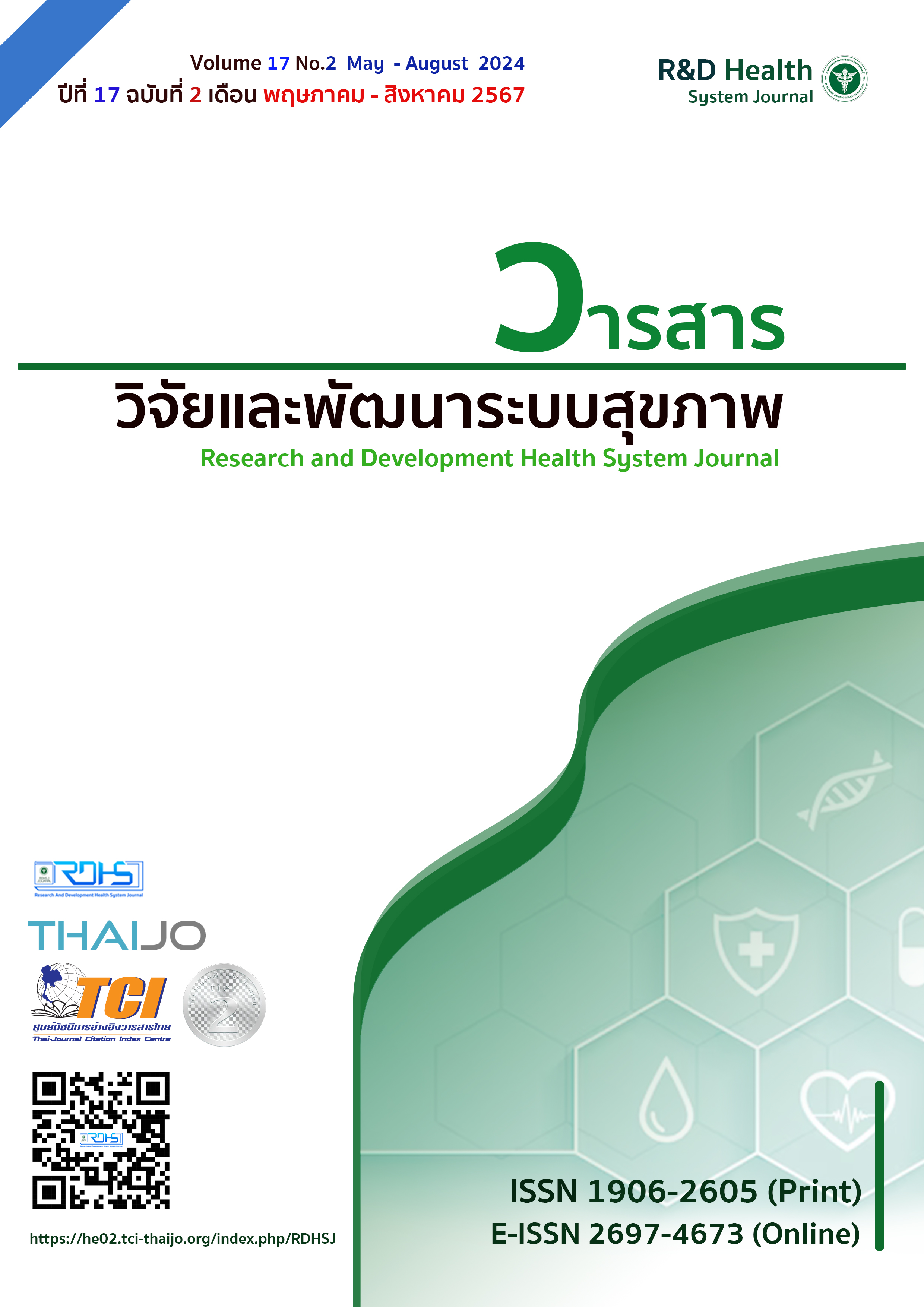การใช้โปรแกรมคอมพิวเตอร์ร่วมกับเอกซเรย์คอมพิวเตอร์สามมิติทางทันตกรรม ช่วยในการวางแผนใส่รากฟันเทียมพิวเตอร์สามมิติทางทันตกรรมช่วยในการวางแผนใส่รากฟันเทียม
คำสำคัญ:
เอกซเรย์คอมพิวเตอร์สามมิติทางทันตกรรม, การวางแผนใส่รากฟันเทียมด้วยระบบคอมพิวเตอร์, ตัวนำเจาะศัลยกรรมดิจิทัล, รากฟันเทียมบทคัดย่อ
ในปัจจุบันการใส่รากฟันเทียมเป็นทางเลือกที่ดีในการทดแทนฟันที่สูญเสียไป การรักษาทางทันตกรรมรากเทียมต้องมีการวางแผนที่ดีเพื่อให้เกิดผลสำเร็จในระยะยาว การฝังรากฟันเทียมแบบดั้งเดิมด้วยมือเปล่า หากทันตแพทย์ไม่มีความชำนาญอาจจะทำให้เกิดผลข้างเคียงที่ไม่พึงประสงค์ เช่น อันตรายต่ออวัยวะสำคัญ ตำแหน่งของรากฟันเทียม และตำแหน่งของครอบฟันที่ไม่เหมาะสมทำให้เกิดแรงกระทำต่อรากฟันเทียมมากเกินไปจนทำให้เกิดความเสียหายต่อรากฟันเทียม และสิ่งประดิษฐ์บนรากฟันเทียมได้ ดังนั้น การวางแผนการปลูกฝังรากฟันเทียมโดยการใช้โปรแกรมคอมพิวเตอร์เครื่องเอกซเรย์คอมพิวเตอร์สามมิติทางทันตกรรม และภาพดิจิทัลจากการถ่ายภาพพื้นผิวในช่องปาก จะช่วยวางแผนจำลองตำแหน่งของการฝังรากฟันเทียม เลือกขนาดรากฟันเทียม รูปร่างและตำแหน่งของครอบฟัน เลือกขนาดรากฟันเทียม และออกแบบตัวนำเจาะศัลยกรรมดิจิทัล บทความนี้ รายงานการรักษาผู้ป่วยที่รับบริการฝังรากฟันเทียม โดยการวางแผนปลูกฝังรากฟันเทียมด้วยระบบคอมพิวเตอร์ และใช้ตัวนำเจาะศัลยกรรมดิจิทัลในขั้นตอนการผ่าตัดกรอเจาะและขยายกระดูก และการใส่ครอบฟันเซรามิกที่ยึดด้วยสกรูจากเทคโนโลยีแคดแคม ภายหลังการรักษา ผู้ป่วยสามารถใช้ครอบฟันบนรากฟันเทียมได้ดี ไม่พบการอักเสบรอบรากเทียมและอาการโยก และให้คำแนะนำผู้ป่วยในการทำความสะอาดบริเวณรากฟันเทียม
Downloads
เอกสารอ้างอิง
ดาราพร แซ่ลี้. ทันตกรรมรากเทียม ขั้นพื้นฐาน. พิมพ์ครั้งที่ 1. ขอนแก่น: โรงพิมพ์คลังนานาวิทยา; 2561.
Otaghsara SS, Joda T, Thieringer FM. Accuracy of dental implant placement using static versus dynamic computer-assisted implant surgery: An in vitro study. J Dent. 2023; 123. Available from: https://doi.org/10.1016/j.jdent.2023.104487
Sun TM, Lee HE, Lan TH. Comparing accuracy of implant installation with a navigation system (NS), a laboratory guide (LG), NS with LG, and freehand drilling. Int J Environ Res Public Health. 2020; 17(6). Available from: https://doi.org/10.3390/ijerph17062107
Alevizakos V, Mitov G, Stoetzer M, See C. A retrospective study of the accuracy of template-guided versus freehand implant placement: A nonradiologic method. J OOOO. 2019; 128(3): 220-6.
Vercruyssen M, Hultin M, Van Assche N, Svensson K, Naert I, Quirynen M. Guided surgery: accuracy and efficacy. Periodontology 2000. 2014; 66(1): 228-46.
สำนักงานพัฒนาวิทยาศาสตร์และเทคโนโลยีแห่งชาติ. 3 ทศวรรษ สวทช. กับการขับเคลื่อนประเทศด้วยวิทยาศาสตร์และเทคโนโลยี : สุขภาพและการแพทย์. พิมพ์ครั้งที่ 1. กรุงเทพฯ: บริษัท แปลน พริ้นท์ติ้ง จำกัด; 2564.
มูลนิธิส่งเสริมวิทยาศาสตร์และเทคโนโลยีในพระบรมราชูปถัมภ์. รางวัลนักเทคโนโลยีดีเด่นและนักเทคโนโลยีรุ่นใหม่ ประจำปี พ.ศ.2562. พิมพ์ครั้งที่ 1. กรุงเทพฯ: บริษัท แพนแปซิฟิคปรินติ้ง จำกัด; 2562.
Deeb GR, Tran DQ, Deeb JG. Computer-aided planning and placement in implant surgery. Atlas Oral Maxillofacial Surg Clin N Am. 2020; 28(2): 53-8.
Tamaseb A, Wismeijer D, Coucke W, Derksen W. Computer Technology Applications in surgical implant dentistry: A systematic review. Int J oral maxillofac Implants. 2014; 29: 25-42.
Zhou W, Liu Z, song L, Kuo CL, Shafer DM. Clinical factors affecting the accuracy of guided implant surgery – A systematic review and meta-analysis. J Evid Base Dent Pract. 2018; 18(1): 28-40.
ดาราพร แซ่ลี้, สิทธิพร รัตนโสภา. ปัจจัยที่ส่งผลต่อความสำเร็จในการรักษาด้วยรากเทียมในเขตสวยงาม : ทบทวนวรรณกรรม และรายงานผู้ป่วย. ว ทันต ขอนแก่น. 2556; 16(2): 136-49.
Spector L. Computer-Aided Dental Implant Planning. Dent Clin N Am. 2008; 52(4): 761-75.
Pimkhaokham A, Jiaranuchart S, Kaboosaya B, Arunjaroensuk S, Subbalekha K, Matttheos N. Can computer-assisted implant surgery improve clinical outcomes and reduce the frequency and intensity of complications in implant dentistry? A critical review. Periodontology 2000. 2022; 90(1): 197-223.
Lui Q, Lui Y, Chen D, Wu X, Huang R, Liu R, et al. Placement accuracy and primary stability of implants in the esthetic zone using dynamic and static computer-assisted navigation: A retrospective case-control study. J Prosthet Dent. 2022. Available from: https://doi.org/10.1016/ j.prosdent.2022.11.005
Gargallo-Albiol J, Barootchi S, Salomo-Coll O, Wang HL. Advantages and disadvantages of implant navigation surgery. A systematic review. Annals Anatomy. 2019; 225: 1-10. Available from: https://doi.org/10.1016/j.aanat.2019.04.005
Yogui FC, Luna Gomes JM, Lemos CAA, Cruz RS, Pellizzer EP. Comparison between computer-guided and freehand dental implant placement surgery: A systematic review and meta-analysis. Int J Oral Maxillofac Surg. 2020; 50(2): 242-50.
Vercruyssen M, Laleman I, Jacobs R, Quirynen M. Computer-supported implant planning and guided surgery: a narrative review. Clin Oral Impl Res. 2015; 26(Suppl.11): 69-76.
Wang X, Shaheen E, Shujaat S, Meeus J, Legrand P, Lahoud P, et al. Influence of experience on dental implant placement: an in vitro comparison of freehand, static guided and dynamic navigation approaches. Int J Implant Dent. 2022. Available from: https://doi.org/10.1186/s40729-022-00441-3
Walker-Finch K, Ucer C. Five-year survival rates for implants placed using digitally-designed static surgical guides: a systematic review. Br J Oral Maxillofac Surg. 2020; 58(3): 268-76.
Smitkarn P, Subbalekha K, Mattheos N, Pimkhaokham A. The accuracy of single-tooth implants placed using fully digital-guided surgery and freehand implant surgery. J Clin Periodontal. 2019; 46(9): 949-57.
Hanozin B, Manni LL, Lecloux G, Bacevic M, Lambert F. Digital vs. conventional workflow for one-abutment one-time immediate restoration in the esthetic zone: a randomized controlled trial. Int J Implant Dent. 2022; 8(1). Available from: https://doi.org/10.1186/s40729-022-00406-6
Yuce MO, Gunbay T, Baksi BG, Comlekoglu M, Mert A. Clinical benefits and effectiveness of static computer-aided implant surgery compared with conventional freehand method for single-tooth implant placement. J Stomat Oral Maxillofac Surg. 2020; 121(5): 534-8.
Lemos CAA, Verri FR, Cruz RS, Gomes JML, Santos DM, Goioto MC, et al. Comparison between flapless and open-flap implant placement: a systematic review and meta-analysis. Int J Oral Maxillofac Surg. 2020; 49(9): 1220-31.
Tallarico M, Meloni SM. Retrospective analysis on survival rate, template-related cmplications, and prevalence of peri-implantitis of 694 anodized implants placed using computer-guided surgery: results between 1 and 10 years of follow-up. Int J Oral Maxillofac Implants. 2017; 32(5): 1162-71.
Do TA, Le HS, Shen YW, Huang HL, Fuh LJ. Risk factors related to late failure of dental implant-a systematic review of recent studies. Int J Environ Res Public Health. 2020; 17(1). Available from: https://doi.org/10.3390/ijerph17113931
ดาวน์โหลด
เผยแพร่แล้ว
รูปแบบการอ้างอิง
ฉบับ
ประเภทบทความ
สัญญาอนุญาต
ลิขสิทธิ์ (c) 2024 สำนักงานสาธารณสุขจังหวัดกาฬสินธุ์

อนุญาตภายใต้เงื่อนไข Creative Commons Attribution-NonCommercial-NoDerivatives 4.0 International License.
เนื้อหาและข้อมูลในบทความที่ลงตีพิมพ์ในวารสารศูนย์ดัชนีการอ้างอิงวารสารไทย ถือเป็นข้อคิดเห็นและความรับผิดชอบของผู้เขียนบทความโดยตรงซึ่งกองบรรณาธิการวารสาร ไม่จำเป็นต้องเห็นด้วย หรือร่วมรับผิดชอบใด ๆบทความ ข้อมูล เนื้อหา รูปภาพ ฯลฯ ที่ได้รับการตีพิมพ์ในวารสารศูนย์ดัชนีการอ้างอิงวารสารไทย ถือเป็นลิขสิทธิ์ของวารสารศูนย์ดัชนีการอ้างอิงวารสารไทย หากบุคคลหรือหน่วยงานใดต้องการนำทั้งหมดหรือส่วนหนึ่งส่วนใดไปเผยแพร่ต่อหรือเพื่อกระทำการใด จะต้องได้รับอนุญาตเป็นลายลักณอักษรจากวารสารศูนย์ดัชนีการอ้างอิงวารสารไทยก่อนเท่านั้น







